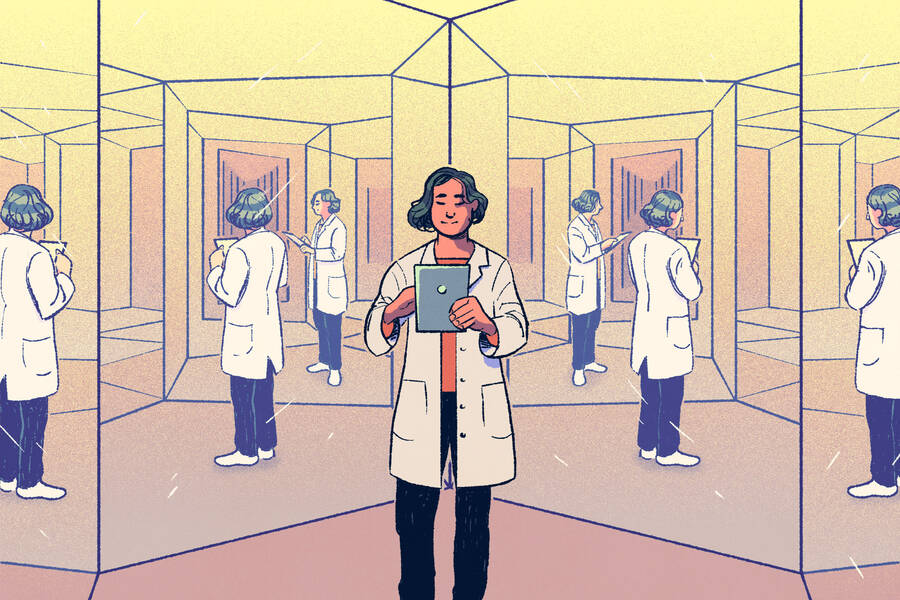But what if the conventional wisdom is wrong—and that using more attention-grabbing language could help scientists gain support for innovative research?
“This goes against the way scientists are trained,” says Brian Uzzi, a professor of management and organizations at Kellogg and codirector of the Northwestern Institute on Complex Systems (NICO) and the Ryan Institute on Complexity. When communicating with peers, he says, “you’re not even supposed to use adjectives.”
The right kind of adjectives, however, might make or break a researcher’s chance at getting their work funded. Uzzi calls it “promotional language”—and after studying nearly 17,000 scientific grant applications, Uzzi and his coauthors (Hao Peng and Huilian Sophie Qiu of NICO, and Henrik Barslund Fosse of the Novo Nordisk Foundation) found that scientists who used it were up to twice as likely to win financial support for their research.
But this was no Mad Men–style advertising trick, bamboozling hapless funders into cutting checks for shoddy science. On the contrary, Uzzi and his partners found that promotional language tended to appear in more intrinsically innovative research proposals—and that the science supported by those successful grants was more likely to be published in high-quality journals. The research team also used machine learning to analyze how promotional language affected the “sentiment” of successful grant applications—that is, whether a reviewer would respond positively or negatively to them. When promotional language in an application was replaced with neutral-sounding synonyms, positive sentiment for that application dropped—indicating that a real-world reviewer would be less likely to approve it.
“Grants are the gateway to doing bigger and better science,” Uzzi says. “This work suggests that promotional language is important not just for securing funding, but for actually conveying the merits of good ideas.”
Defining “promotion”
Some research has already been done on what makes for a successful scientific grant application—and the results suggest that truly innovative work can be a hard sell. In fact, says Uzzi, “more novel grant proposals tend to be rejected.” However, the study showing this correlation only analyzed 30 applications. Uzzi and his collaborators, meanwhile, were able to draw on a much larger sample size of 16,730 grant applications—both successful and unsuccessful—submitted to the National Institutes of Health (NIH), the National Science Foundation (NSF), and the Novo Nordisk Foundation. “This gave us a much stronger basis upon which to make our inferences,” Uzzi says.
To measure promotional language within this dataset, Uzzi and his coauthors relied on a lexicon of 139 words gathered in 2022 by linguist Neil Millar. Usage of these words—like “unique,” “revolutionary,” and “fundamental”—rose significantly in successful NIH grant applications between 1985 and 2020. By analyzing their frequency in both successful and unsuccessful applications, Uzzi and his colleagues hoped to determine whether these promotional words moved the needle on a grant’s ability to secure funding.
However, the researchers were also interested in promotional language’s ability to successfully communicate the importance of novel scientific ideas. To gauge the inherent innovativeness of a grant proposal, Uzzi relied on a measure he published in Science in 2013, which looks for unconventional pairings of citations within scientific papers.
“Scientists generally combine ideas from the past,” he explains, “but many papers combine that past knowledge in very familiar ways”—for instance, citing Albert Einstein and Isaac Newton in the same physics paper. Innovative papers, meanwhile, contain more unusual pairs of citations. Uzzi likens it to ingredients in a recipe: “tomato sauce and garlic is a combination that’s going to appear in a lot of different recipes, but garlic and ice cream would be unusual.”
Since grant proposals also contain citations of prior scientific work, Uzzi’s metric could provide a similar measure of innovativeness in the grants in their dataset. And comparing that inherent innovativeness with the frequency of promotional words in a grant proposal—and with the grant’s success or failure—would shed light on whether promotional language helped communicate the value of innovative science.
Believing the hype
Uzzi and his coauthors found a clear association between promotional language and successful grants. On average, one out of every hundred words in their sample of grant applications was promotional—about one promotional word for every four sentences. In the majority of grants, increasing the frequency of promotional words from 1 to 2 percent was associated with a 46 percent increase in the likelihood of funding success.
But this wasn’t mere hype at work: the researchers also found that promotional language was associated with more innovative research proposals. According to Uzzi’s metric, grant applications with two promotional adjectives for every hundred words—about twice as many as usual—were 54 percent more innovative than the average proposal.
Furthermore, the science that actually came out of these proposals tended to have high merit as well. By tracking the scientific papers that resulted from these successfully funded grants, Uzzi and his coauthors showed that the same amount of promotional language in a proposal—two words out of every hundred—led to subsequent publications increasing their predicted journal impact factor (a measure of how often the typical article in that journal is cited) by 51 percent higher than average.
“People tend to say, ‘Well, isn’t promotional language just a lot of window dressing? Isn’t it just hyping up a lot of science that doesn’t deserve it, and weakening research overall as a consequence?’” Uzzi says. “What this research shows is that scientists are using promotional language in a judicious way that reflects the true innovativeness of their work.”
Of course, as any good scientist knows, correlation does not imply causation—so Uzzi and his collaborators needed a way to show that the use of promotional language could actually cause the effects they observed. To do this, Uzzi and his coauthors devised a “what if” experiment to simulate how removing promotional language would affect a grant proposal’s success.
First, the researchers assembled a list of neutral synonyms for the 139 promotional words in their lexicon: for instance, replacing the word “unique” with the more neutral-sounding “specific” or swapping “revolutionary” for “different.” Then they replaced promotional language in the grant proposals with these neutral words.
Next, the researchers used a machine-learning model to categorize the “sentiment” of each version of the grants. (Sentiment analysis, which measures the positive or negative emotional tone of a text, is a common task in natural language processing.) There’s no way to know for sure how real-world grant reviewers would have reacted to alternate versions of the proposals. But prior research has shown that positive sentiment is associated with grants getting approved—so by measuring the difference in sentiment between promotional and non-promotional versions of the proposals, Uzzi and his coauthors could estimate how the change in wording might have affected their chances of success.
When all of the promotional words were replaced with neutral terms, the positive sentiment significantly dropped for more than 80 percent of the proposals—suggesting that they’d be less likely to secure funding. What’s more, Uzzi and his coauthors found that promotional language was actually a better predictor of success than generic positive sentiment.
“Once you put in the right measure, the previous one ceases to be relevant,” Uzzi explains.
Hidden tracks
To Uzzi, these findings puncture the long-held notion that cold, hard data is the only thing that matters to doing good science. Instead, using language that helps highlight the significance of that science—“hype”, in less-charitable terms—can actually be a crucial part of advancing scientific knowledge, especially when it comes to supporting novel research whose significance may not be immediately obvious even to specialists.
“It’s not about changing perception—it’s that something important may not even exist to you until your mind is prepared to understand it,” says Uzzi. “If you and I were walking through the forest, we might be treading over all kinds of animal footprints and never know it, not because they are not there but because we aren’t trained to see them in the first place. Promotional language helps stimulate and direct your attention to things that you may not have realized were worthy of it.”
So should scientists resist their traditional “just the facts, ma’am” impulses and intentionally use more promotional language when seeking support for innovative research? Uzzi’s answer is unequivocal: “I would say yes.”
The reason, he asserts, isn’t to hype up breakthroughs where none exist—it’s to make sure real breakthroughs actually get a chance to happen. “What we see in the data is that even if your grant has great ideas, the absence of promotional language lowers your chance of getting funding,” Uzzi says. “And that diminishes things for the rest of us, because good science doesn’t get recognized and adopted.”




